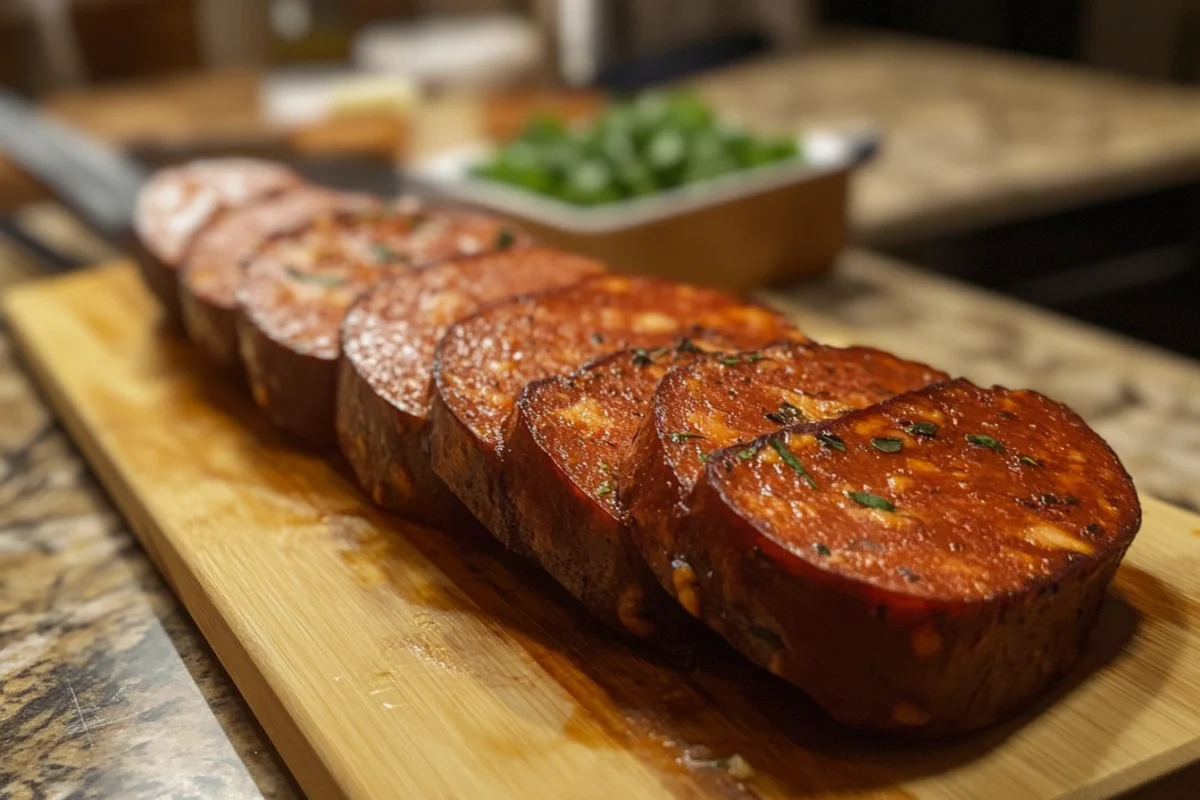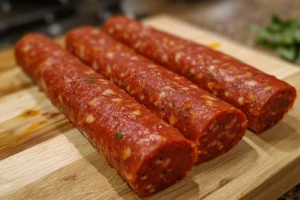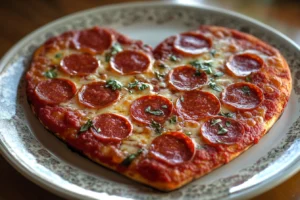Old World Pepperoni Curl: 5 Amazing Secrets to its Ultimate Form
Old World Pepperoni Curl, Old World pepperoni, with its distinctive curled edges, is a popular choice for pizzas and charcuterie boards. The unique shape and slightly charred texture contribute to its appeal. However, have you ever wondered what causes this characteristic curling? The answer lies in a combination of factors related to its casing, preparation, and cooking method. Let’s delve into the incredible secrets behind this tasty phenomenon.
This is similar to how the secrets of puff pastry rely on layers of butter for flakiness.
The Essential Role of Natural Casing in Old World Pepperoni
The most significant contributor to the Old World pepperoni curl is the use of natural casings. Unlike the collagen or cellulose casings often used in mass-produced pepperoni, natural casings are made from animal intestines. These casings have varying thicknesses and natural shrinkage patterns that are essential for the unique cooking experience. They provide an element of authenticity.
Differences in Casing Materials
Natural casings, unlike their synthetic counterparts, possess an irregular shape. This irregularity means that during the drying process some parts of the casing lose moisture quicker than others. Consequently, these variations create differential tension. These differences ultimately contribute to the irregular curling we see in old world pepperoni. In addition, natural casings are more porous, which aids in moisture release. This breathability affects drying time as well.
Shrinkage During Cooking
When natural-cased pepperoni is cooked, the casing shrinks more rapidly than the meat inside. This uneven shrinkage forces the edges of the pepperoni to pull inward creating the classic curved shape we all recognize. This process is different compared to collagen casings, which shrink more uniformly and often do not produce the same level of curling. Therefore, the material makes a noticeable difference. The material influences cooking.
The Impact of Pepperoni Preparation Methods
The method used to prepare Old World pepperoni plays a big part in how it curls. From the grinding process to the stuffing and drying of the meat, each stage impacts the final outcome. These methods directly influence the texture and moisture content, which in turn affects how the casing will react during the cooking stage. Therefore, every step is crucial.
Grinding and Mixing Process
The grinding process for old world pepperoni is typically coarser, which results in a meat mixture that isn’t as densely packed. This more open texture allows for better airflow during drying and cooking. Further, mixing spices thoroughly throughout the mixture ensures uniform flavor distribution. Therefore, consistent grinding and mixing are important steps to take. This allows for better airflow through the product.
Stuffing and Curing
Once the meat is prepared, it’s stuffed into natural casings which are usually hand-tied at intervals forming links. Then, the stuffed sausages undergo a period of curing. This involves precise control of temperature and humidity levels. During curing, the meat loses moisture, and the casing begins to tighten around the filling. This process further amplifies the potential for curling as the moisture loss is not uniform throughout the product. This is what gives it it’s characteristic flavor. Image Placeholder: alt text includes “Old World Pepperoni Curing Process”
The Importance of Cooking Methods on Pepperoni Curl
The final step that really determines the degree of Old World pepperoni curl is the cooking method. High temperatures in particular cause a rapid release of moisture and create a distinctive cupping effect. The way that old world pepperoni is cooked, especially on pizza, contributes to its unique charm. Therefore, the type of heat used makes a difference. The heat level is not a suggestion; it is a necessity.
High Heat Environment
When Old World pepperoni is exposed to high heat, particularly in a pizza oven, the rapid heating exacerbates the difference in shrinkage rates between casing and filling. This is why you’ll often see intense curling when pepperoni is baked directly on a pizza. The high temperature forces the casing to contract quickly and pull the edges of the pepperoni upwards. This creates a cupped shape quickly.
Charring and Texture
Moreover, high heat causes the edges of the pepperoni to char slightly, which adds to the flavor and texture. The charred edges become crispy and provide a wonderful contrast to the softer center of the meat. This charring not only contributes to the flavor profile, it also enhances the visual appeal of the curled pepperoni. It is both visual and flavor enhancement.
Factors That Affect the Degree of Curl
While natural casing and cooking methods are the primary reasons for Old World pepperoni curling, there are other subtle factors that can influence how much the edges will curl during cooking. These additional factors create slight variations in appearance. Therefore, multiple conditions play a part in the process. These small changes are visible.
Thickness of Slices
The thickness of the pepperoni slices can influence the extent of curling. Thinner slices tend to curl more dramatically than thicker slices. This is because thinner slices have a higher surface area exposed to heat and are more susceptible to the rapid moisture loss that causes curling. Therefore, a slight variance in thickness results in a noticeable difference. The cut of the slice is critical.
Moisture Content Before Cooking
The moisture content in the pepperoni before it is cooked is a critical variable. Drier pepperoni may curl more quickly as the casing will shrink faster. In contrast, pepperoni with more moisture may take longer to achieve a significant curl. These differences in starting moisture content result in different cooking dynamics. Moisture control is essential.
Age of the Pepperoni
The age of the pepperoni can also play a role in the degree of curl. Older, drier pepperoni tends to curl more intensely. Fresher pepperoni, which retains a little more moisture, might take slightly longer to reach its full cupping potential. Therefore, time and environmental exposure play important roles. The freshness level does make a difference. Image Placeholder: alt text includes “Old World Pepperoni Texture Comparison”
The Secret Recipe for Perfect Pepperoni Curl
Achieving the perfect Old World pepperoni curl on your pizza comes down to a few key points. By understanding what influences the curling process, you can make decisions that will enhance both the flavor and visual appeal of your dish. Therefore, a well planned process helps create the best results. You can control the result.
Choosing the Right Pepperoni
First, it is essential to select Old World pepperoni that uses natural casing for that authentic curl. Next, you will want to avoid pre-sliced pepperoni that has been overly processed. Also, consider the moisture content. Look for pepperoni that feels dry to the touch which suggests that it will curl nicely during cooking. The right ingredients are the key.
Preparing for Cooking
Make sure to cut pepperoni into slices of consistent thickness to achieve uniform results during cooking. Don’t overload your pizza with too many slices of pepperoni as this can block heat circulation. Finally, distribute slices evenly across the pizza. This promotes balanced cooking and consistent curling. Avoid overcrowding for the best results.
Cooking Techniques
When baking pizza, preheat your oven to a high temperature. This rapid and intense heat is essential for creating curled pepperoni. Also, you may want to position pepperoni pieces so that there’s room for hot air to circulate around all sides of each slice. This makes sure the heat gets to all sides. Image Placeholder: alt text includes “Pizza with perfectly curled Old World Pepperoni”
The Appeal of Curled Pepperoni
Beyond flavor, the curled edges of Old World pepperoni have become a visual indicator of quality. This unique presentation is appealing to consumers and elevates the overall dish, contributing to a more sophisticated and authentic look. It’s a symbol that indicates time and craftsmanship went into the preparation. It creates a level of artistry.
Visual and Aesthetic Appeal
The curled edges create texture and dimension on pizza and charcuterie boards that make it look more enticing. The crispy edges provide a delightful contrast to the soft center. This visual appeal is a large part of why Old World pepperoni is valued among both chefs and consumers. This unique look adds sophistication.
Enhanced Flavor Profile
The charring on the curled edges not only looks appealing, it also intensifies the pepperoni’s flavor. This is because the Maillard reaction occurs at high temperatures and produces a range of complex flavor compounds. This is what leads to a richer, more layered taste experience. Flavor development is a complex process. Image Placeholder: alt text includes “Close up of charred Old World Pepperoni edges”
The Science Behind the Curl
The curling of Old World pepperoni isn’t just a happy accident; it’s rooted in scientific principles. Understanding the interplay of factors at a molecular level can further explain why this specific type of pepperoni behaves the way it does. Therefore, the scientific backing is significant.
Water Activity and Moisture Migration
Water activity plays a crucial role in the curling process. Natural casings, being porous, allow water to migrate out of the pepperoni meat during curing and cooking. As water moves from the meat to the surface of the casing, it creates an environment that causes the casing to contract unevenly. This uneven contraction leads to the characteristic curl, and water is the key player.
The Maillard Reaction and Flavor Development
The Maillard reaction is a chemical process that occurs when amino acids and reducing sugars in the pepperoni react at high temperatures. This reaction is responsible for the formation of hundreds of flavor compounds. As the edges of the pepperoni curl, they are exposed to more heat, promoting the Maillard reaction. It creates the desirable flavors and aromas of browned meat.
Collagen Structure and Heat Sensitivity
Natural casings are composed primarily of collagen, a protein that undergoes structural changes when exposed to heat. When heat is applied, the collagen fibers within the casing contract. The rate of this contraction isn’t uniform throughout the casing, leading to the curl. The casing proteins respond strongly to heat.
The Tradition of Old World Pepperoni
Beyond the science and technique, there is also a rich tradition and history behind Old World pepperoni. It is a product of time-honored methods passed down through generations. Understanding this history can add a deeper appreciation for this unique food. Therefore, the tradition is important.
A Culinary Heritage
The use of natural casings and traditional curing methods dates back centuries. These methods were developed to preserve meat before refrigeration, and have been refined over time. They are a part of our culinary history. The process is a valuable one.
Artisanal Craftsmanship
The process of making Old World pepperoni is labor-intensive. It requires skill and patience. Artisanal pepperoni makers are dedicated to preserving the authenticity of this product. Their craftsmanship is a huge part of the appeal. This makes it such a valuable food.
The Taste of Authenticity
Old World pepperoni embodies a connection to traditional food practices. It offers a unique taste and texture that differs greatly from mass-produced varieties. Its unique flavor and appearance sets it apart. This sense of heritage adds value to this food.
Conclusion
In summary, the incredible Old World pepperoni curl is the result of a complex interplay. This includes its natural casing, careful preparation, and high-heat cooking methods.
FAQ
Why do some pepperonis not curl?
Pepperoni that doesn’t curl is typically made with collagen or cellulose casings. These casings shrink uniformly, preventing the cupping effect seen in natural casing pepperoni. They are designed to remain flat. They are a different product.
How does the drying process affect pepperoni curl?
During the drying process, natural casings lose moisture unevenly, creating tension that leads to curling during cooking. Synthetic casings don’t shrink as inconsistently, resulting in less curling. The process makes a difference. The uneven drying creates the desired results.
Does the amount of heat influence pepperoni curl?
Yes, high heat is essential for the rapid shrinkage of natural casings, which causes the edges to curl. Low heat generally doesn’t produce significant curl. The heat must be intense. The temperature makes all the difference.
Can you make pepperoni curl more?
You can enhance curling by using natural casing pepperoni and cooking it at high temperatures. Thinner slices might also curl more. You can also experiment with different types of ovens. You can influence the outcome with techniques.
Similar principles apply when crisping up other foods, like air fryer potato skins, where surface area and fat content play a key role.



